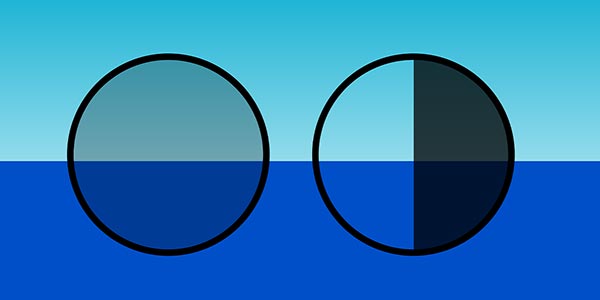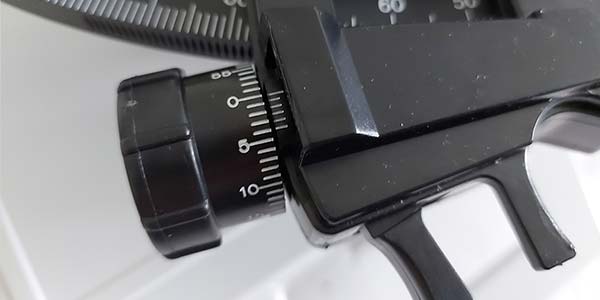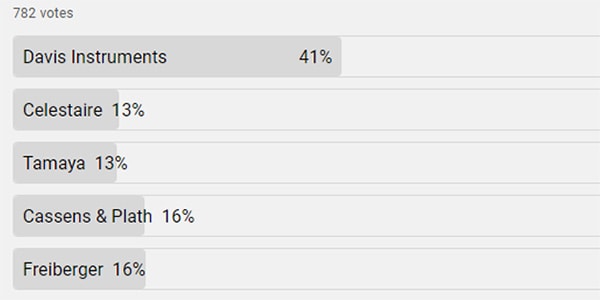The Ultimate Guide To Buying A Sextant: Which Is Best?
As an Amazon Associate, Casual Navigation earns from qualifying purchases.
Buying a sextant can be a bewildering process. Searching the main models shows they range in price from <$50 to $2,000+. Including the second-hand market as well, you’ll struggle to know where to start.
When I bought mine, I faced the same struggle. In the end, I developed my own process to narrow down the options, eventually leading me to select and purchase my favourite.
The best sextant is the Mk15, made by Davis Instruments. Constructed in plastic, it is one of the most affordable models, yet it retains sufficient accuracy and durability for use by all but the most demanding navigators.
Despite my recommendation, however, you should always conduct your own assessment of which is best. Almost certainly your requirements will be different to mine.
My choice was made primarily from an educational perspective. I wanted the best sextant, that would help the greatest number of students to learn, while still giving sufficient accuracy to produce reliable results.
Had I wanted the best sextant for a supertanker to navigate in the event of an electrical blackout, I would have chosen something like the C&P Professional, or the Tamaya Spica instead.
Both are professionally accurate metal sextants, but that is reflected in their price.
As with any purchase, buying a sextant is all about balancing your needs with your available budget.
Throughout the rest of this guide, I am going to take you through my process for working out exactly what you need from your sextant so that you can be sure you will buy the one that is right for you.
What should I look for when buying a sextant?
In buying your sextant, the first thing you should consider is your own experience level. It is going to become a factor in all the other considerations as we discuss them.
For example, a beginner is going to benefit from things that might make sight-taking easier, as well as things that would help you learn.
An experienced user, however, might benefit from factors that improve accuracy, without needing to worry about it being slightly more difficult to take initial sights.
No matter how experienced you are, you should always consider the following points.
New vs used
A new sextant from a reputable manufacturer is likely to have fewer defects than a used sextant.
Used sextants, on the other hand, are likely to be priced lower than new models.
The main consideration in buying a used sextant is whether you have enough experience to determine if any potential errors are due to defects in the instrument itself, or due to your own skill.
For this reason, I always recommend that new users intending to take actual sights should only consider a new sextant.
If you have a little experience and would be happy to determine whether the sextant you are buying is in good condition, then you might consider a used sextant as well.
Assuming you have the skill to assess a used model, your decision about new vs used will primarily come to cost.
Metal vs plastic
If you ask any professional navigator whether you should buy a metal sextant or a plastic sextant, you will almost certainly be told that metal is best.
In some ways, they are right. A metal sextant is likely to be more sturdy, and produce a more accurate sight than a plastic sextant.
In other ways though, a plastic sextant is best. A plastic sextant is likely to be lighter to hold and more affordable than a metal sextant.
Indeed, once you start to consider the accuracy that you actually need from a sextant, metal sextants actually start to lose their advantage.
You usually use a sextant when you are far away from land, with a clear horizon visible. In these conditions, it doesn’t actually matter whether your position is accurate to within 3 miles or within 6 miles. Within 3 miles of danger, you should not be navigating with a sextant anyway.
There is no doubt that a skilled navigator can get a higher level of accuracy with a metal sextant. Unless you are navigating a large ship though, it is questionable whether you would actually benefit from the additional theoretical accuracy.
In the debate about metal sextants vs plastic sextants, I always recommend you consider that both offer sufficient accuracy for most use cases.
Your decision between metal or plastic should be based on weight, durability and cost instead.
Split mirror vs semi-silvered mirror

The horizon mirror of a sextant can either be a split mirror, or a semi-silvered mirror. Most models offer an interchangeable mirror, but some will only come with one option.
Split mirrors make it easier to see the reflection of dim objects, but offer a smaller reflective surface making it harder to bring the object down to the horizon.
Semi-silvered mirrors, due to their larger reflective area, make it easier to bring objects down to the horizon, but then make it harder to see dim objects.
Personally, I prefer a split mirror because it makes all reflections clearer to the user. I like to locate a star with the sextant set at 0°, then center it in the reflective portion of the mirror. With the star centered, I then bring the sextant down to the horizon, moving the index arm to keep the star central.
I find that the additional reflective properties of the split mirror make it easier to keep focused on the star.
Semi-silvered mirrors can be easier if you struggle to hold a sextant steady, but you might find the star harder to re-locate if it momentarily strays off the edge of the mirror.
Micrometer/vernier
The term “micrometer” and “vernier” are often used interchangeably when talking about sextants.
Either way, it is just referencing the scale that is used for fine measurements of the sextant’s angle.

Technically, a vernier is just a type of scale used on a micrometer. The micrometer is the mechanical part that is moving, and the vernier is the scale that you read to actually get the angle.
When buying a sextant, you should make sure you are familiar with the mircometer/vernier on the model you choose.
Some will advertise that they have a “vernier”, and others will advertise that they have a “micrometer”.
On almost all occasions, they are actually talking about the same thing. Just make sure you check before you buy.
Accuracy
With sextants, there are a few different types of accuracy that they will tell you.
Firstly, there is the accuracy of the vernier. Some may offer accuracy of 0.2’, and others may offer accuracy of 0.1’. This is an absolute limit, based on what is physically possible with the scale.
The other type of accuracy that they will reference is the “potential accuracy” of the instrument in general. This is from their experience based on what they believe could be attained by a user.
No matter what accuracy your sextant claims, there will be other factors that lead to far greater inaccuracies than the instrument itself. For example, the accuracy of your timepiece and how precisely you record the time after taking your sight.
If you are interested, you can find out about lots of the different inaccuracies in this article: How Accurate Is Celestial Navigation Compared To GPS?
In summary, whether your sextant claims to be accurate to within 0.1’ or within 0.3’ is largely irrelevant. What is more important is that you get one that you will be comfortable using, and practising with.
Scope
The scope, or telescope, is the part of the sextant that you look through to find stars.
Most sextants offer magnification in their scope, but others will just come with a viewfinder that is literally a tube.
Magnification makes it easier to see stars and line them up with the horizon. It makes the star appear larger in the mirror, making it easier for you to see.
Larger scopes are useful if you need to measure dimmer stars, but they are not necessary for measuring larger bodies like the sun or the moon.
When buying your sextant, you should see what scope it comes with, but don’t worry too much about searching for the greatest possible magnification. The only time I recommend large magnification is if you will be completely reliant on the instrument for navigation.
In that case, the larger scope gives you more possibilities for measuring more stars, increasing your chances of a fix when clouds cover part of the sky.
Otherwise, most people will find a 3X optical scope, or even just a viewfinder, is plenty for what they need.
Weight
The weight of the sextant is primarily affected by its construction material. Metal sextants weigh more than plastic sextants.
Your sextant’s weight will be more of a consideration for a beginner than for an experienced user because a beginner is more likely to be holding the sextant for extended periods.
Likewise, the weight will probably be a bigger consideration if you are planning on using the sextant on a small boat that rolls around. Holding a lighter weight will actually be safer than holding a heavier weight.
Consideration of the weight of your sextant will influence your decision about whether you decide to buy a metal or plastic instrument.
If you decide you want a metal sextant, you still have further options as they all weigh different amounts. For example, aluminium frames weigh less than brass frames.
Mirror size
A sextant has a horizon mirror and an index mirror, both of which could be different sizes or shapes.
The larger the mirrors, the easier it is to stay focused on the celestial bodies that you are measuring.
You will tend to find newer sextants have larger mirrors than older models. Modern manufacturing techniques allow greater precision for larger mirrors than was possible before.
Otherwise, the only way to know which mirror size is best for you is to pick them up and try them for yourself. Generally, you will find perfectly adequate mirrors on all modern sextants.
Illumination
With a sextant, references to illumination only refer to the vernier and arc. The idea is that a small amount of light on these parts allows you to read the scale in the dark.
An illuminated scale can make it quicker and easier to take multiple sights during the short twilight window.
Whenever I have been asked, I don’t actually recommend illumination on a sextant though. My reason is that if it is too dark to read the scale, it will be too dark to write down your readings. You will need a torch for writing, so you may as well use the torch to read the sextant as well.
Illumination is a nice feature to have on a sextant, but I would never buy one just because it has illumination.
Price
The final consideration when buying your sextant is price.
My biggest piece of advice is to only spend what you are comfortable spending. There are perfectly good sextants for lower budgets, and there are perfectly good sextants for higher budgets.
The most important thing is to get one that you will be comfortable using. Never spend so much on your sextant that you are afraid to use it.
How much should you spend on a sextant?
| Experience | Budget |
|---|---|
| Beginner (Plastic) | Around $200 |
| Beginner (Metal) | Around $1000 |
| Professional (Lifeboat) | Around $50 |
| Professional (Metal) | $2000+ |
*Prices are always fluctuating, so for up-to-date pricing, follow the links below.
Pro Tip: You will find sextants on offer for less, but they are usually “antique” or “collectable” versions rather than accurate navigational tools. Make sure you read the details.
For entry-level beginners, you could get my favourite sextant, the Davis Mk 15 (link to Amazon). You can read my full review of the Mk15 in this article: Davis Mk15 Sextant Review.
Otherwise, the Davis Mk3 (link to Amazon) costs less, but it does not operate in the same way as a true sextant. I only actually recommend the Mk3 for experienced users who want to leave a sextant in a grab bag or lifeboat.
If you are looking for an entry-level metal sextant, I recommend the Astra IIIB from Celestaire (link to Amazon). Again, it is one of the most affordable models on the market and will give most of the performance of a metal sextant at an entry-level price.
For professionals looking for a sextant that will provide sufficient accuracy for a merchant or military vessel, I recommend going directly to the manufacturer as you will be spending in excess of $2000 to get the model you need.
Sextant Brands
In the sextant industry, there is still a range of brands offering accurate instruments.
By far the most popular brand is Davis Instruments because they offer the most affordable models on the market.
I asked over 750 of my viewers which sextant brands they had used, and over 40% had used a Davis Instruments model.

Davis Instruments
Davis Instruments are known for producing modern plastic sextants.
In the middle of their range is the Mk15, my current favourite sextant. You can read my full review of the Mk15 in this article: Davis Mk15 Sextant Review.
Celestaire
Celestaire is best known for producing the Astra IIIB, which is the most affordable metal sextant on the market.
If you are looking for a metal sextant, Celestaire should be one of the first manufacturers you check out.
Frieberger
Frieberger sells a range of small metal sextants, designed for use by sailors on yachts. Their sextants are a similar price to Celestaire’s Astra IIIB model, but they are designed to be smaller and easier to store on small boats.
Tamaya
Tamaya is a Japanese brand, producing a selection of professional metal sextants.
Cassens & Plath
Cassens & Plath is a German brand, producing a selection of professional metal sextants.
